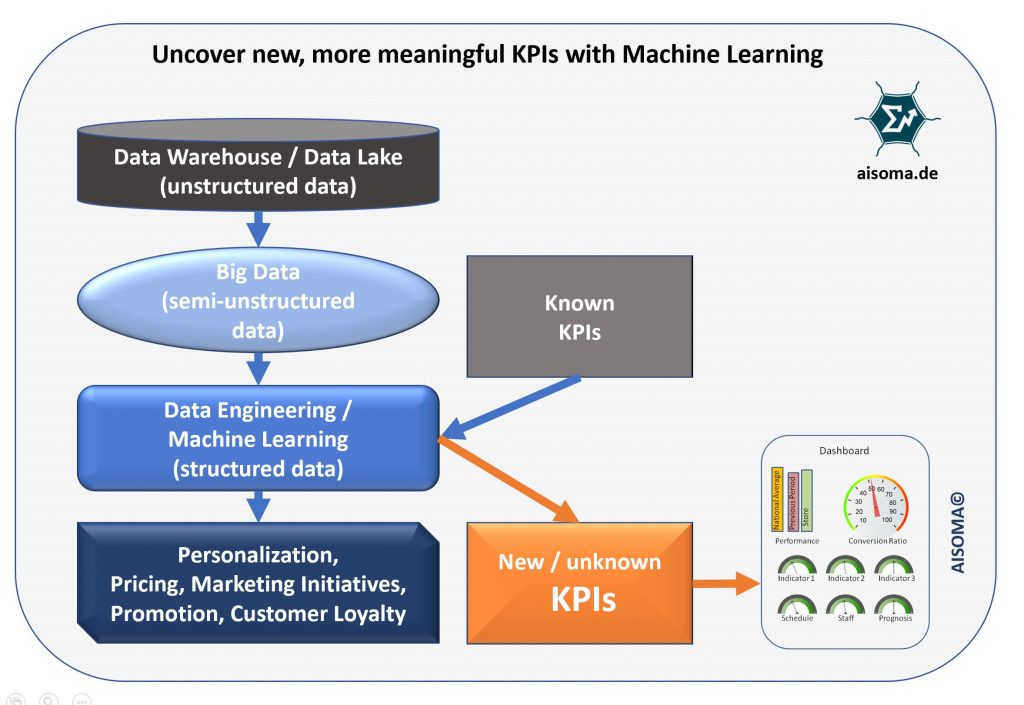Machine learning can help companies identify completely new metrics in a rapidly changing market.
It is well known that machine learning is already helping companies achieve their performance goals by optimizing existing performance metrics. By leveraging the growing volume of data on customer behavior, pricing, competitive action, and operational statistics, it can deliver critical insights in a variety of ways. Machine learning offers many benefits from optimizing marketing or pricing to improving customer service and operational efficiency. However, a recent article in the MIT Sloan Management Review shows that companies are increasingly using machine learning to identify entirely new KPIs to correlate with overall performance.
So how can machine learning change KPIs?
You don’t need machine learning to conclude that the measurement of “total income,” for example, is better than just the “base rate”. This applies in particular to companies with considerable “additional income” such as airlines. Airlines mainly track the “load factor” and the “average return.” Success requires a balance between the two. ML can be used to find less apparent metrics that correlate with overall success.
Machine Learning can uncover new, more meaningful KPIs

[bctt tweet=”Uncover new, more meaningful KPIs with Machine Learning #MachineLearning #AI #KPI #AIBusiness #Business ” username=”AISOMA_AG”]
Meeting needs in a continually changing market:
New KPIs that can influence the overall success better than old KPIs in case of changes in the market or the competitive environment. With the growing importance of additional income, for example, new, supplementary key figures have become more useful.
Let’s stick to the example of airlines:
Let us take a closer look at the ancillary fees. Let’s assume that airlines whose incidental expenses account for almost 50% of total income are disproportionately dependent on baggage fees. For some airlines, baggage revenue per passenger may even be just as crucial for full revenue performance as the basic fare. With some baggage fees that exceed 30€, for example, the difference between a customer who pays for baggage or not will often be more than the fare premium for the next higher fare. The absence of baggage fees for a particular flight could easily mean 20% less revenue (possibly the difference between a highly profitable flight and a financial disaster).
Therefore, baggage revenue per passenger can be a critical KPI for these airlines; monitoring both charges and load factors to maximize this source of income is fundamental to the airline’s financial success. Similarly, machine learning could identify other critical revenue sources that ultimately increase the profitability of flights or sectors, and that should be considered as essential KPIs for the company.
To go one step further, baggage revenue can be maximized for specific fare types or specific flights or customer segments. Isolating the factors – or customer profiles – that generate the most significant revenue from impact bags can help a company focus on the right levers for success.
Is baggage turnover higher for business travelers or young families?
How do baggage revenues vary by channel?
Machine learning can help airlines identify new KPI’s that further improve performance on a customer segment, channel, or market basis.
Focus on greater personalization and segmentation:
New merchandising tools based on greater customization mean that different segmentation systems are relevant. ML can help identify which client segments should be the focus of more targeted offerings – and new segment-specific KPIs that are designed to meet individual client needs better can be a better way to overall success.
Machine learning offers enormous potential for gaining new, competitive insights. Instead of merely using machine learning “just” to optimize performance based on traditional KPIs, it can also be used to identify new KPIs that can prove much more useful in a continually changing marketplace.
Do you have any questions?
AISOMA
Further reading: AI-Readiness – Is your business ready for the use of AI? A checklist with 7 points.